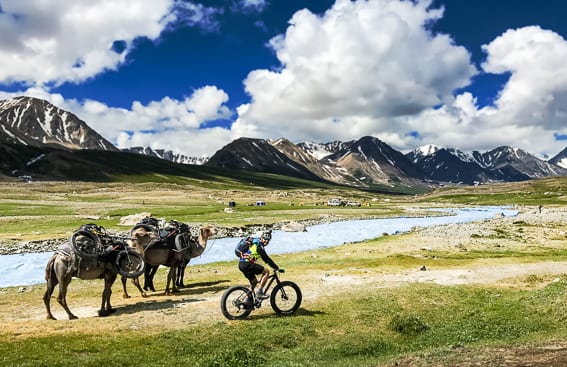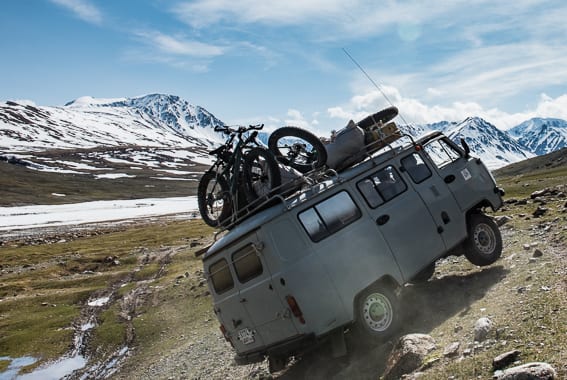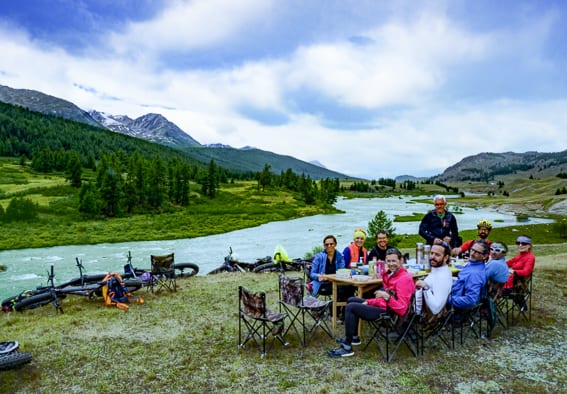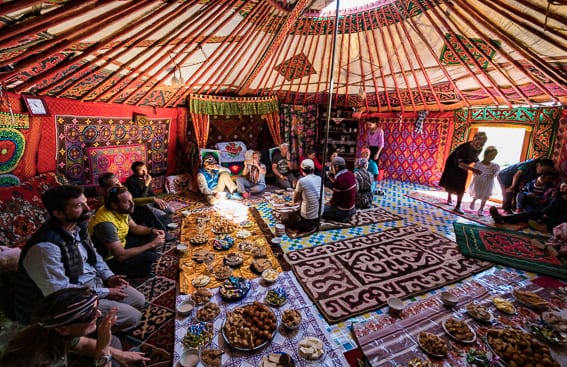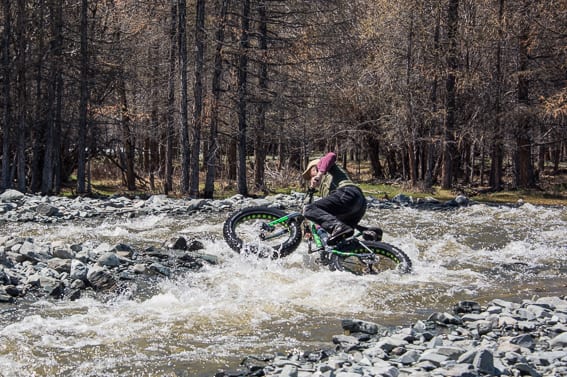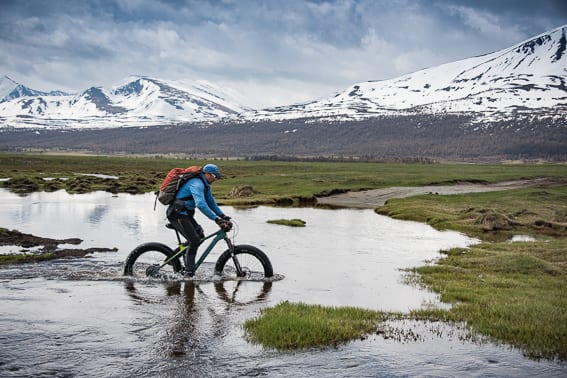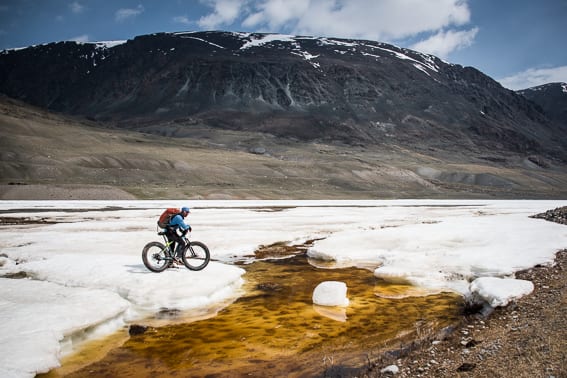SITTING IN: interview with Kirsten Scully
Kirsten Scully Travel Mongolia 10 June 2018
We are very excited to have Kirsten from Round Square Adventures join us today for this week’s ‘Sitting In’ interview. Kirsten has a background as a professional photographer and filmmaker. She lives in Spain but has worked all over the world. As an outdoor adventure sports enthusiast, she set up Round Square Adventures. We came across the company and thought that they offer something a little different to traditional bike holidays. As such, we were keen to learn a little more.
UNFOUND: Kirsten, thank you for taking the time to talk to us. Before we get on to all things Round Square Adventures, tell us a little bit about you, Nacho (your business partner) and your cycling backgrounds?
KIRSTEN: Thanks for having us! Both Nacho and myself have done all kinds of crazy stuff throughout our careers. Nacho grew up in the Picos de Europa in the north of Spain, has worked as a cave rescuer for years, he’s climbed and mountain guided all over the world and has always biked. He started climbing in his early teens, tried his hand at wearing a suit to work after getting a degree in graphic design, (found that very unsatisfying) and subsequently did his training as an instructor at the School of Mountaineering in Benasque, Spain, later working as a climbing instructor and an instructor in wilderness survival techniques.
I started doing triathlons in my 20s when it wasn’t a big sport. After a few skiing and enduro motorbike injuries, I turned to biking, first as therapy and it quickly became one of my passions. As a photographer I worked for Frommer’s travel guides all over Europe and South America, Maine Media workshops in Uganda, America’s Cup and organised photography workshops in Spain, Morocco and Cuba. I grew up living in the US, England, Spain, France and Argentina, so traveling and experiencing different cultures has always been a part of my life. Nacho and I have done a lot of bike packing in some truly wonderful places, but when I went to Mongolia as a photographer, both Nacho and I came back with the conviction that we wanted to make that part of Mongolia a permanent part of our lives. We have biked in some truly wonderful places, but Western Mongolia topped them all. We have met some wonderful people out there who were keen to work with us and everything fell into place. We set up Round Square Adventures so that we could share the experience we’ve gathered on our world travels with other like-minded travellers….on bikes of course!
UNFOUND: So built out of a passion to show people the amazing sights and sounds of Mongolia, how did you decide on Fat Bikes as the mode of transport?
KIRSTEN: What attracted us to Mongolia as much as the wild terrain in the Altai Mountains, were the nomads and their culture. Their lives and customs have been shaped by the migration of their livestock, which is their life support. They move house and home four to five times a year depending on what the climate has done to the pastures that year. We wanted a mode of transport that would get us easily and safely to all the places the nomads go while at the same time, moving at a pace which would encourage interaction with them. Cars whizz by too fast, walking is too slow…fat bikes adapt to the terrain of the Altai Mountains…open steppe, rock gardens, animal trails… and of course the weather where the amount of snow fallen during the winter has a direct affect on the volume of water flowing down the rivers and streams which we have to cross. Fat bikes will take you comfortably and safely over the most troublesome terrain. Wet stone, muddy paths, snowy hills, sand dunes…they don’t slip and sink into the mud like a narrower tired wheel would. On every single trip we go on I get offers from the nomads to swap my fat bike for a horse or two.
UNFOUND: Tell us about the format of your tours? How long, how far each day are you cycling?
KIRSTEN: Getting to remote places where people live in symbiosis with nature in today’s world of computers, internet and airplanes, is surprisingly not that easy. There aren’t that many places left in the world that aren’t easy to get to; it’s part of what we like about Western Mongolia. Actually getting there is a bit of a challenge, which means that you find fewer people doing the same thing as you are. Once you get there, you get that feeling that you are on a real adventure, off the beaten track.
Guests arrive in Ulan Bator, spend a day and a night there, enough to see the main sights of the city and the following day take a two and a half hour flight on a small Fokker 50 prop plane to Olgii which is not far from the Russian and Chinese borders. We leave the town in three indestructible Russian UAZ furgons and once off the 500 metres or so of tarmac road leaving town, you can say goodbye to your internet, telephone and much of the technology that we think is indispensable in our lives…it has no meaning or functionality where we go. We spend 10 days experiencing the nomadic way of life, going to their festivals, sharing meals with them, seeing how they care for their prized golden eagles and immersing ourselves in the rhythm of their lives. We have a translator who works tirelessly helping us to communicate with the locals.
We also carry generators so we can charge our cameras and computers for those who choose to bring them. I am a photographer and charging cameras and editing is a daily part of my workflow. We don’t really count the km that we do, a better measurement are hours spent in the saddle, which is usually around six on a normal day. We might do anything between 20 and 40 km/day. We have to be versatile as far as our itinerary goes, due to changing weather conditions and if we hear about a wedding or celebration going on, we’ll divert so we can join in.
We have three support vehicles with us, which means that there is always one following in case someone doesn’t want to ride their bike. Our bikes are new Trek Farley 5s and Nacho is an excellent mechanic…all bikes are oiled and checked at the end of each day’s ride. Most of our adventures are two weeks long, however, I have organised 10 day trips for people who might not be able to take off quite so much time. We also organise custom trips for people who have a specific idea of what they’d like to do.
UNFOUND: Where do you stay each night?
KIRSTEN: Due to the remoteness of the area, we do make a huge effort to make everyone as comfortable as possible. No one wants old, leaky tents or air mattresses with holes in them after a long days ride. Our equipment is top of the line. We always stay for a couple of nights in gers, which are the Kazakh yurts, all with raised beds and conventional mattresses. For the other days we stay in four season, three person North Face VE25 for couples and two person Kelty tents for those traveling on their own. We have a big dining tent with tables and chairs, a cook’s tent, a shower tent (with a pump shower and hot water) and of course a latrine tent with a toilet and seat. It’s all very civilized!
UNFOUND: What’s the food like?
KIRSTEN: Our Kazakh partner has just built a hotel and restaurant in Olgii. He had a chef from Ulan Bator come to Olgii this winter to train several expedition cooks so they could use local produce to turn out dishes which are more palatable to the Western tongue than what the nomads would traditionally eat. Their staple diet is mutton, their own particular version of homemade cheese and curd. Thanks to a well-stocked supermarket in Olgii, we bring lots of fruit and vegetables, which are not available in the countryside. A typical breakfast would be much the same as you would have at home, coffee, tea, hot chocolate, cereal, yogurt, eggs, porridge, pancakes, toast, butter and fruit. Lunch is prepared beforehand and consists of soup and salad, rice, pasta, potato salad, beef, lamb or chicken and fruit. We take along a couple of fishing rods and often have fresh fish from the lakes or rivers for dinner. We have had several vegetarians on our trips; keeping them fit and healthy on our trips is not a problem.
UNFOUND: And what about Mongolia, give us five unique or fun facts about the country.
KIRSTEN:
– 30% of Mongolia’s population is nomadic; one of the few nomadic cultures remaining in the world. They are herdsmen and survive by moving their livestock to wherever the best pastures are.
– Mongolia has just two people per square km. People are very friendly and always invite travellers in for a cup of milky tea and biscuits. Our experience is that they are fascinated by foreigners and love to hear about where we are from.
– Western Mongolia is one of the few places in the world where the tradition of hunting with Golden Eagles survived through Russian communism. The tradition goes back 4,500 years. Many of our Kazakh friends who we visit on our trips are Eagle Hunters.
– Naadam is a traditional festival where one can see wrestling, horse racing and archery. The festivals are held throughout the summer months. We make sure our guests don’t leave Mongolia without experiencing this unique event.
– Mongolia is one of the world’s highest countries with an average of 1,580 m. We take our guests up to the Potanin Glacier (camels carry the bikes much of the way) which sits at the bottom of Mongolia’s highest Khuiten peak.
UNFOUND: We’ve seen some of your photos and know you have a background in photography but still, the scenery is breath taking. We are believers that you see the world differently on two wheels, how would you best describe the whole experience if you are a roadie looking to do something a little bit different?
KIRSTEN: I’m right there with you. One does see the world differently on two wheels, whether they are skinny or fat, big or small. We live in a wonderfully privileged age where scientists and developers have come up with miracle materials that we can choose from for different situations, clothes that weigh literally nothing that will keep us warm in -40 C weather, carbon fibre bikes that weigh less than 6 kgs; everything has it’s place and purpose. As bikers, we know that using our body’s energy to push us forward on two wheels releases something in our brain that generates feelings of intense joy, satisfaction, achievement and a whole bunch of other irrational emotions not many people that don’t bike would understand. Roadies, bike packers, enduro riders or recreational mountain biker; it’s the same feeling. Couple this with incredible scenery, nomads, new cultures, wildlife, eagle hunters, having the possibility to push oneself slightly outside of one’s comfort zone; and you have a trip of a lifetime. Our trips are not technically difficult as far as biking goes. It’s more important to have a keen sense of adventure and a good sense of humour as things in Mongolia do not always work as one might expect.
UNFOUND: We know that your tours sell out extremely quickly. However, if someone reads this and wants to plan a trip, do you have anything left this year?
KIRSTEN: We still have a couple of spaces left on our September trip, which includes the Golden Eagle Festival. The dates are the 4th Sept – 18th Sept. The dates for next year’s trips are all up on the website (visit our group on the hub for more details).
UNFOUND: And finally, what is the most impressive thing you have seen or experienced on the bike?
KIRSTEN: Agii, our Kazakh fixer, is an interminable source of laughter and bemusement. Our first recon trip was in May a few years ago when there was still a lot of snow on the ground and the big rivers were still frozen. There was a ton of water coming down from the mountains. Agii hadn’t ridden a bike since he was a child but he had decided that this was going to be his new sport so we found an almost new, Scott Big Jon in Spain, packed it up and took it with us to Mongolia. He was delighted. Forget the padded shorts, bike shoes or any kind of special clothing; he took off for a two-week recon trip with his corduroy trousers, wool sweater and Mongolian leather horse riding boots.
It was also our first trip riding in Mongolia. Nothing would stop him, there was no river that was too deep or fast running, no mountain too steep, no ice too thin for him to tackle with his fat bike.
Nacho and I would stand on the banks of a river wondering how we were going to cross without getting swept away in the freezing glacial water, concerned about getting soaked and having to ride for the rest of the day in cold, wet boots and clothes. Meanwhile Agii would be half way across the river with water up to his waist wondering what the problem was. A few images are much better than words at describing the unfazed and determined persistence we find amongst all the Kazakh Mongolians we work with in the Altai Mountains. They are incredibly welcoming people, know the terrain like the back of their hands and are some of the hardest working people I’ve ever met.
UNFOUND: Kirsten, thank you so much for taking the time to speak to us, your trips sound inspirational; a proper adventure and importantly, a real escape from the intense, unrelenting pace of modern society.
-
Round Square Adventures
Visit site
